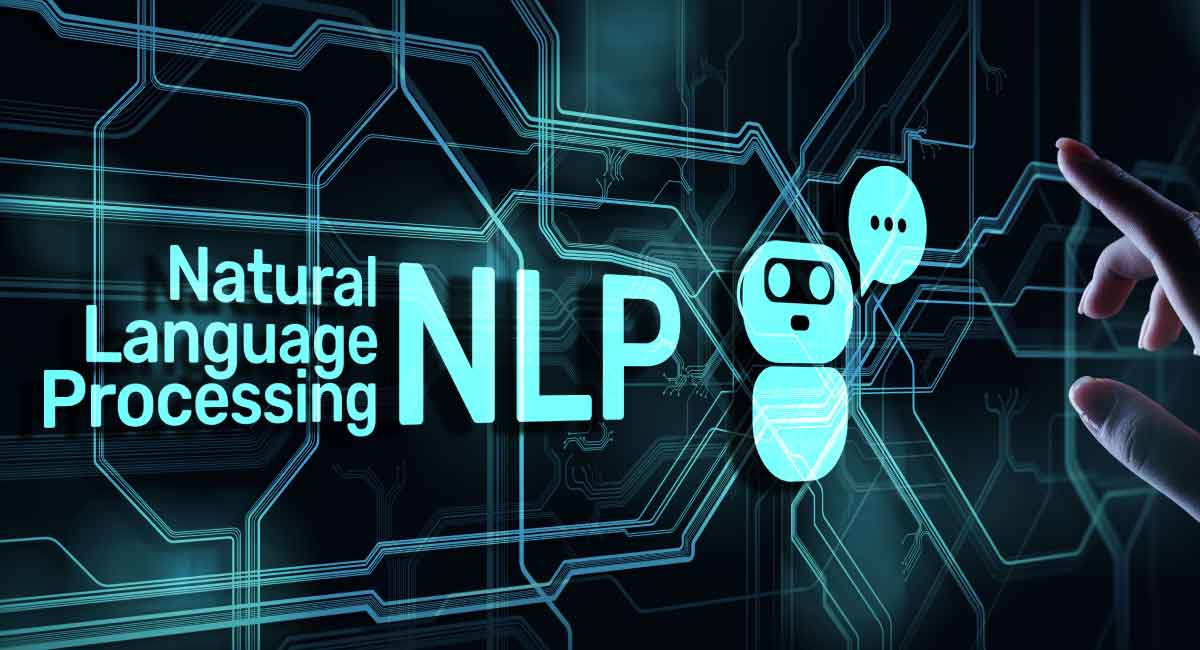In 2022, ChatGPT took the world by storm and brought AI to the public’s attention. Behind ChatGPT’s ability to understand and generate human-like text is natural language processing (NLP) — a field of artificial intelligence that focuses on enabling computers to understand, interpret, and generate human language. But long before ChatGPT, NLP has been driving a wide range of applications we use daily.
This article will discuss NLP, its working principles, benefits, and how businesses use it. If you want to gain a more in-depth understanding of NLP, read to the end of this guide, where we’ll explore a globally recognized data science course that can help you build a career in data science.
What is Natural Language Processing in Data Science?
Natural language processing is the part of data science that enables computers to understand human languages. In this branch of AI, algorithms observe and analyze human language in text and voice. NLP then extracts data, discerns patterns, and generates new text based on the meaning.
This is a challenging field due to the dynamic nature of human languages. Hence, the focus is on enabling the computer to understand human languages spoken by collecting and treating as many data samples as possible.
The most common example is predictive search results, where you only have to type in a couple of words, and Google provides multiple options for you to select. Here, Google uses NLP to gather all the possible search results that begin with the two words and ranks them according to their popularity.
Another widely used example is the auto-translation service offered by Microsoft on its Outlook application. Outlook analyzes your email interactions and identifies text in a different language than your regular one. The option to ‘Translate this text’ pops up to enable you to understand the email properly.
Types of Natural Language Processing in Data Science
Understanding language is a massive exercise. Going on a straight path and trying to design algorithms for all the aspects of language is impossible. Hence, NLP has been divided into different categories that deal with only one aspect of the language at a time. Let us take a look at the main types of NLP.
Sentiment Analysis
Sentiment analysis deals with discerning the patterns of words related to specific sentiments. This type of text is classified as projecting a positive, negative, or neutral sentiment. This is critical in today’s customer-focused world, where enterprises want to know how the customer feels and predict the best way to serve the customer. Hence, as a data scientist, you may design algorithms to study the text in the emails, chat transcripts, phone call transcripts, and social media posts to accurately predict the mood of the customers the moment they communicate with the enterprise.
Keyword Extraction
Keyword extraction involves critical keywords and phrases specific to a particular situation, trend, or topic. This NLP type analyzes massive amounts of unstructured data to identify mentions in numerous online documents, including blogs, websites, social media posts, and news articles. Keyword extraction can be performed by creating algorithms that can filter useable keyword mentions to help identify business opportunities and the reach of the product.
Knowledge Graph
Knowledge graphs collate information such as people, things, places, events, concepts, and situations in a graph network to understand their interrelationships. This natural language processing category is a step ahead of textual analysis, as it encourages the machine to go deeper into the nuances of the language based on context. The machine is no longer restricted to simple word identification and tagging. It can enhance contextual data collection and comprehension.
Word Cloud
Word cloud is the type of NLP that tells which words were used in a text and how many times they were used. Instead of relying on usual bar charts or plots, word cloud uses a visual representation of the frequency of the word usage. All the words are placed together in the shape of a cloud and are ordered from largest to smallest. The words used most frequently are displayed in a larger font, while the lesser-used words are given in smaller fonts. The focus is on the most used words to analyze the topics, mentions, and trends. AI automatically generates word clouds to analyze feedback, surveys, and other documents quickly.
Text Summarization
Text summarization is a sequence-to-sequence model. It takes long texts as the input and summarizes the text’s main points as the output. This NLP is useful when large documents have to be outlined for analysis. In this type, unimportant content is removed, and a shorter semantic version of the sentences and phrases is displayed. Text summarization is conducted through two approaches—extractive and abstractive. While the extractive approach highlights the critical points in a text and presents them as a precis, the abstractive approach understands the nuances of the language to summarize the key points.
How Natural Language Processing Works
Natural language processing is a complex method that uses multiple steps to analyze text. Here’s how it works.
- Lexical: The first step assesses the text on a word level. The different words, their grammatical form, tense, and their relationship with other words are analyzed. It assesses the words and phrases into free and bound morphemes, indicating how they are formed.
- Syntax: Further, the sentence structure is examined. The position of the words, whether the subject, object, or verb, the location of clauses and phrases, and the overall sentence formation are observed.
- Semantics: The sentences are individually analyzed to understand their meaning. This takes NLP a step above word-based analysis, combining the sentence’s meaning with the word’s contextually appropriate meaning.
- Discourse integration: Discourse integration assesses the previous sentences to note the context for the following sentence. It tries to narrow down the sentence’s subject by gauging the last sentence’s theme.
- Pragmatics: Finally, the text as a whole is examined for meaning and sentiment. Sentences are studied in relation to other sentences to note the critical topic and its features, such as definition, principle, types, etc.
There are many tools for conducting NLP. These tools may be available either as SaaS or as open-source libraries. SaaS tools have pre-trained NLP models that can be used directly. You can also use APIs to code some parts of the model freely.
Meanwhile, open-source libraries are free and allow for flexibility in customizing tools. These are complex and are used mainly by experienced professionals who can build open-source tools. Open-source libraries are used if you want to develop an NLP tool from scratch. Several of these libraries are based on the Python language.
Here’s a quick list of the natural language processing tools you should consider learning as a data science professional.
- GenSim
- TextBlob
- SpaCy
- MonkeyLearn
- IBM Watson
- Google Cloud NLP API
- NLTK
- Aylien
- Amazon Comprehend
- Stanford Core NLP
A reputable data science program will help you hone your skills and utilize these tools for maximum efficiency.
Advantages of NLP in Data Science
Natural language processing has several benefits that make it attractive to enterprises worldwide. Let’s examine some of these benefits.
- Enables a large amount of data to be assessed in a meaningful manner
- Can analyze both structured and unstructured data, such as a collection of social media posts and messages
- Provides detailed market analysis and brand reach
- Capable of scouring multiple documents related to a subject to gauge its presence and mention
- NLP-enabled AI lowers costs by automating routine tasks and reducing the time and resources spent on them
- It can be customized to accommodate the unique requirements of the industry
Use Cases of Natural Language Processing in Data Analytics
We now have a general idea of what NLP is. To help you understand it better, let’s discuss a few use cases.
Product Returns
E-commerce applications provide AI-enabled online chatbots. The chatbots are trained using many historical conversation logs and online interactions. The chatbots ask the customer to choose a task based on the most common tasks in the data.
Once the customer selects requests for a product return, they direct them to determine the return order. The customer then has to provide a reason. The list of reasons is based on the previous responses by other customers.
Finally, the chatbot will ask how the customer wants to be refunded. Let’s say the customer provides an answer not included in the chatbot in any of these steps. Then, the answer is captured and directed to the NLP algorithm, which analyzes it and includes it in the next software update.
Social Media Crisis Response
Suppose a hair product has a quality issue. Someone posts online about it, and it starts trending. Several others post about their experiences with the same hair product or the company. Natural language processing scans social media for keywords such as the hashtag, brand name, product name, and location of the posts.
Further, it reviews the text for sentiment analysis and flags the marketing team when negative sentiment increases. The marketing team alerts the sales and quality teams. The NLP automatically responds to social media posts with negative sentiments to handle this crisis until the enterprise officially responds on its social media site.
Industry Standards
Standards are large documents that provide guidelines for a particular industry’s process or testing. They contain sections and sub-sections that are updated every couple of years. NLP can be used to analyze these documents and highlight the critical changes by comparing them with previous versions. It can also summarize the chief points in the standard for a quick review.
Of course, like any other technology, natural language processing has certain limitations. For instance, it does not have human experience. Hence, it can analyze text based on only the data it has been trained on. It cannot understand sarcasm, slang, voice tonality, and emotions well. NLP struggles with ambiguity and ends up providing erroneous interpretations. It lacks independent thinking and relies solely on the input.
Techniques Used in NLP Analysis
Several techniques have been devised to conduct NLP analysis. Some of these can be used independently, while others must be used together for the most meaningful result. Here are some of the popular techniques.
- Tokenization: Tokenization works by breaking down the text into words referred to as ‘tokens’ that are analyzed independently. The tokens help simplify the text and group sentences with the same tokens together. Here, punctuation and hyphens are eliminated.
- Stop word removal: Stop words refer to articles, prepositions, and simple verbs such as ‘is,’ ‘the,’ ‘a’, ‘an’, ‘as,’ etc. These words add little to no value to the overall text and are removed from the critical word analysis so that the focus remains on the keywords. This helps reduce the usage space by eliminating the noise from the data.
- Text normalization: Text normalization works by stemming and lemmatization. Here, words with similar roots are grouped in a single token and reduced to their root form. For example, ‘writing’ and ‘written’ are reduced to ‘write’ and grouped.
- Feature extraction: In this technique, the keywords or features are identified and extracted for further analysis. For instance, in marketing campaigns, the marketing team will introduce a hashtag and then track how many times the hashtag was used across several demographics. The posts will also be subjected to a sentiment analysis to gauge customer response.
- Word embeddings: In word embeddings, NLP assigns numbers to the keywords in a document. This converts the text to real-valued vectors and simplifies the analysis.
- Topic modeling: Topic modeling is a technique that focuses on topics rather than words. It assumes a topic is a group of words and a document comprises several topics. Thus, the algorithm scans the document for the topics and extracts them to give a meaningful analysis.
Learn NLP Algorithms and Other Data Science Concepts
Natural language processing has immense potential, and opportunities in this field are expected to grow exponentially in the coming years. Gaining expertise in NLP can give you an edge if you’re looking to build a lucrative career in data science.
A reputed data science bootcamp is designed to equip you with NLP and other essential skills to shine in a data science career. By joining, you can take advantage of live, interactive classes led by industry experts, hands-on training through practical and capstone projects, and networking with peers.






